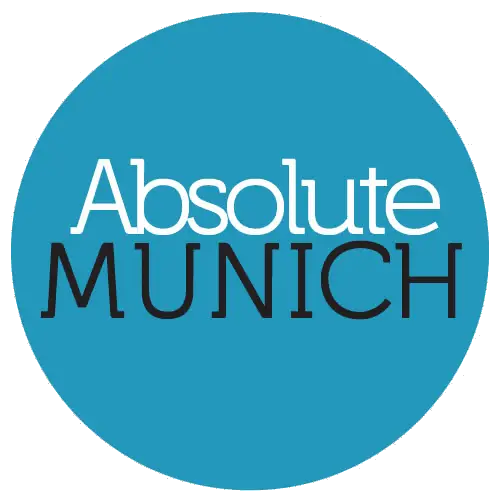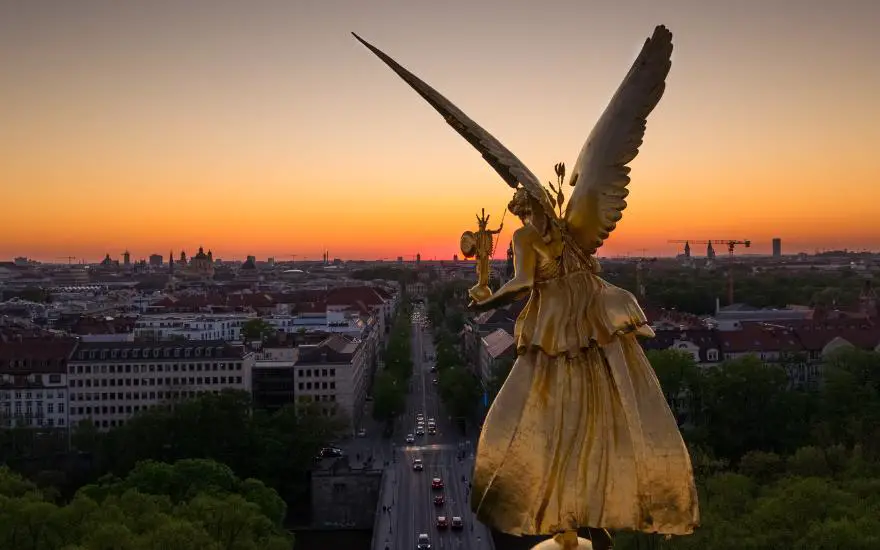Munich is a city that’s steeped in history & culture but with so many Iconic Munich Landmarks to choose from, it can be difficult to know where to start and which to visit first!
Well, that’s where Absolute Munich comes in to help by providing this comprehensive guide to Munich’s Monuments, Landmarks & Sculptures.
We’ll explore the 21 most famous Landmarks of Munich (according to us here at Absolute Munich) that’ll give you a glimpse into the city’s amazing past and popular present.
From the impressive Olympic Tower (Olympiaturm) to the musical theatre of the Glockenspiel, Munich has a landmark of some sort to interest anyone!
So if you want to take in the iconic sights and sounds of this vibrant city, with the help of this article, you can effortlessly plan your trip and make the most of your time in Munich by knowing which Munch Landmarks you’d like to see!
Our list is in no particular order but please note that this is an article about Munich Landmarks, not places, parks, things to do and see, or similar – it’s all about LANDMARKS!
Let’s get cracking, shall we?

1. Endless Staircase
The Endless Staircase, also known as Umschreibung, is a unique piece of street art located in the Schwanthalerhöhe district of Munich. Created by Danish-Icelandic artist Olafur Eliasson, the sculpture is a spiral staircase that appears to have no end.
The Umschreibung is hidden in the courtyard of an office building, making it a bit of a challenge to find. However, it is worth the effort for those who appreciate exceptional architecture and art.
The sculpture is a beautiful example of Eliasson’s work, which often explores the relationship between space, light, and perception.
The Umschreibung is a popular destination for tourists and locals alike, and it is free to visit. Visitors can no longer walk up the staircase and experience the disorienting feeling of being in a space that seems to have no beginning or end, but this is still a fab place to visit.
To reach the Umschreibung the walk will take around 40 minutes from the center of the city, but there is plenty to see on the way. For those who prefer not to walk, there are other transportation options available.
For a full guide on this Munich Landmark please read our full article entitled Endless Staircase Munich: A Powerful Statement Of Bavarian Street Art
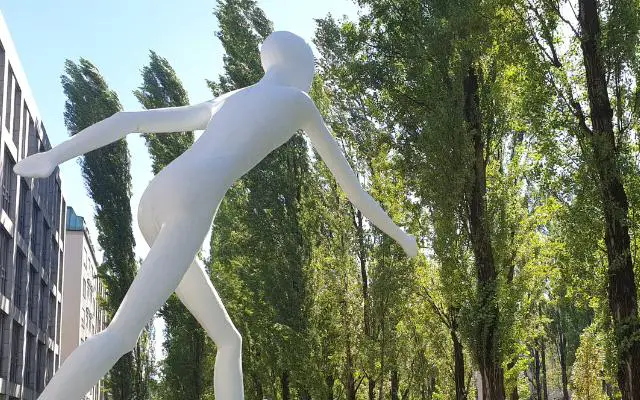
2. Walking Man
The Walking Man is a sculpture located on Leopoldstraße in Munich. It was created by Jonathan Borofsky and was presented to the public on September 21, 1995. The sculpture stands at a height of 17 meters (56 feet) and weighs 16 tonnes (35,000 pounds).
The Walking Man is a popular landmark in Munich and is often visited by tourists and is located next to the Munich Re business premises, just a few minutes’ walk north up Leopoldstraße from the Munich Siegestor.
The sculpture seems right at home in Schwabing, where the modern part of the city shines in this upmarket suburb.
The Walking Man is a unique sculpture that captures the imagination of visitors. It is a symbol of movement and progress, and its size and scale make it an impressive sight to behold. The sculpture is a testament to the creativity and ingenuity of the artist.
Tourists can easily reach the sculpture by taking public transportation or by walking from nearby landmarks such as the English Gardens or Nymphenburg Palace.
For more on this Amazing Munich Landmark please read our comprehensive blog post on the sculpture entitled Walking Man Munich: Who Is He?
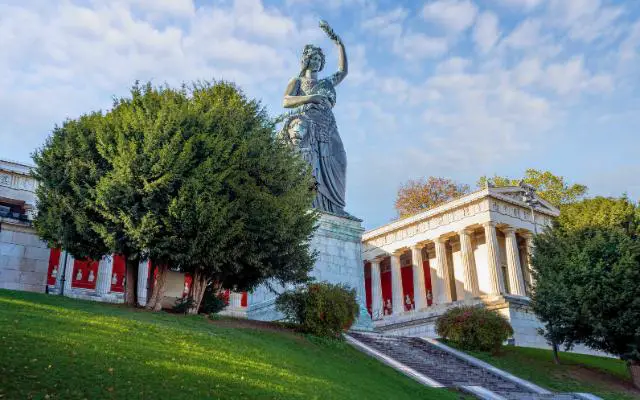
3. Lady Bavaria Statue
The Bavaria Statue is one of the most iconic landmarks of Munich located on the western edge of Theresienwiese and at an impressive height of 18 meters, it’s particularly hard to miss.
Designed by famous Munich artist Ludwig Schwanthaler, and commissioned by King Ludwig I. It was cast in bronze between 1843 and 1850 and is the first colossal statue to be made entirely of bronze since the classical period.
The statue is a personification of the Bavarian homeland and represents its strength and glory. It is a female figure with a lion at her feet, symbolizing strength and power.
The statue’s right hand holds a wreath of oak leaves, while the left hand holds a sword, symbolizing peace and defense. Visitors can climb up to the head of the statue and enjoy a beautiful view of Munich.
The Bavaria Statue is part of an ensemble that includes the Ruhmeshalle and a stairway. The Ruhmeshalle, or Hall of Fame, is a neo-classical building that houses busts and statues of famous Bavarians, including scientists, artists, and politicians. The stairway leads up to the statue and is decorated with various sculptures and reliefs.
Visitors to Munich should not miss the opportunity to come and visit Lady Bavaria for themselves and if you’d like to know more, then read this article entitled Bavaria Statue Munich: Lady Bavaria Of The Theresienwiese
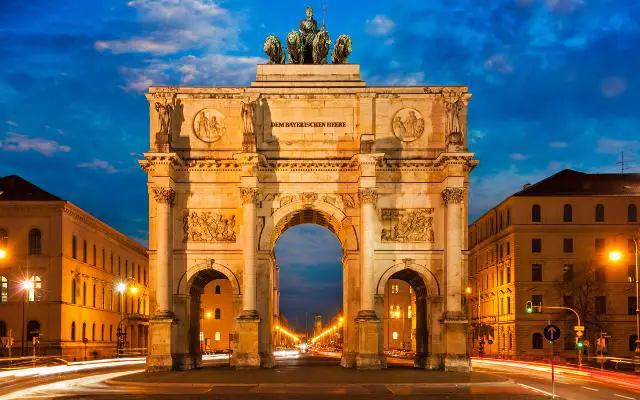
4. Siegestor
The Siegestor, or Victory Gate, is one of Munich’s most famous landmarks. Located at the northern end of Ludwigstrasse, it is a three-arched memorial arch that stands as a reminder to peace.
The monument was originally dedicated to the glory of the Bavarian army, but since its restoration following World War II, it has become a symbol of peace.
Designed by Friedrich Gärtner, the Siegestor is 21 meters high, 24 meters wide, and 12 meters deep. It is crowned with a statue of Bavaria with a lion-quadriga, which is a chariot drawn by four horses. The gate is made of white limestone and decorated with reliefs that depict scenes from Bavaria’s history.
The Siegestor was built in the mid-19th century and was modeled after the Constantine Arch in Rome. It is located between the districts of Schwabing and Maxvorstadt, and it is a popular tourist attraction. Visitors can take the U-Bahn No. 3 or 6 to Universität and stroll north past the University to reach the Victory Gate.
The Siegestor is not only a beautiful monument but also an important part of Munich’s history. It is a must-see for anyone visiting the city.
Its location at the northern end of Ludwigstrasse makes it a perfect starting point for a Walk Through Munich’s Old Town.
For a comprehensive look at the SIegestor Munich check out this article entitled Siegestor Munich: Bavarias Famous Victory Gate
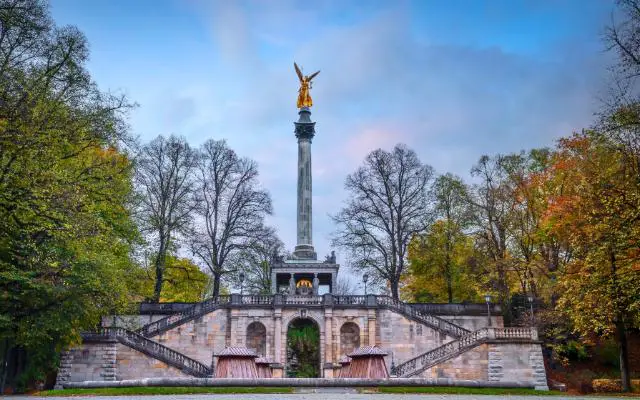
5. Friedensengel
The Friedensengel, also known as the Angel of Peace, is a 38-meter-high monument located in Munic that was erected in 1899 in memory of 25 years of peace following the Franco-Prussian War of 1870-1871.
The monument is situated on the eastern end of Prinzregenten Strasse, overlooking the Isar River.
The Friedensengel is an impressive sight to behold with its grand and gold structure. It is based on the Greek god Nike, the goddess of victory.
The monument is a bit like the city’s guardian angel, calling for peace. In fact, it is dedicated to peace more so than its counterpart in Berlin, which is dedicated to the victory in the Franco-Prussian War.
Visitors can climb the two staircases to the observation deck located above the fountain. From there, they can enjoy a panoramic view of the city. The monument is surrounded by a beautiful park, making it an ideal spot for a leisurely stroll or a picnic.
The Friedensengel is a significant landmark in Munich, and it attracts many visitors every year. It is a symbol of the city’s commitment to peace and serves as a reminder of the importance of diplomacy and cooperation between nations.Find out more about this wonderful Munch Landmark by reading the full article entitled Angel Of Peace Munich: A Symbol Of Serenity & Remembrance
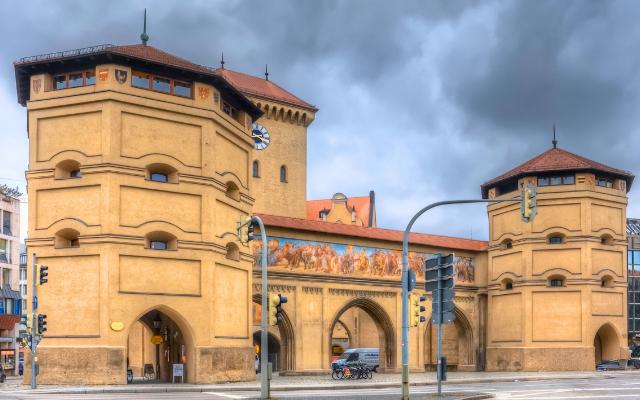
6. Isartor
The Isartor is one of the three remaining Gothic town gates of medieval Munich, located in the eastern part of the city. It was built in the 14th century and is the only gate that still has its main tower intact. The tower was originally built to mark the eastern city limit of Munich, facing the Isar River.
The gate is massive and consists of a 40-meter-high main gate tower. Two flanking side towers were later additions to serve as a barbican. Visitors can walk through the gate and explore the museum inside. The museum showcases the history of Munich and the gate’s significance in protecting the city from invaders.
The Isartor is an important landmark in Munich’s history and has been well-preserved over the centuries. It’s a popular tourist destination due to its historical significance and unique architecture. Visitors can take a stroll around the gate and admire the intricate details of the Gothic architecture.
In addition to its historical significance, the Isartor is also an important transportation hub. The S-Bahn station Isartor is located nearby, making it easy for visitors to access the gate and explore the surrounding area. Check out full details of this enduring part of the Munich City Walls by exploring our article entitled Isartor Munich | The Amazing Medieval Eastern City

7. Ruhmeshalle
The Ruhmeshalle, also known as the Hall of Fame, is a historic building in Munich designed by (then) court architect Leo von Klenze. The building was constructed in 1853 as part of a complex that includes the Bavariapark and the Bavaria statue.
The building is situated on an ancient ledge above the Theresienwiese in Munich and is made of Kelheim limestone. It is 68 meters long and 32 meters wide and features a Doric colonnade with a main range and two wings.
Inside the Ruhmeshalle, visitors can find busts of famous Bavarians, including artists, politicians, and scientists. The building was commissioned by King Ludwig I of Bavaria, who wanted to create a nationalistic Germanic drive and make Munich a new “Athens on the Isar.”
The building’s architecture and design are impressive, and the busts of famous Bavarians inside the hall are a testament to the rich cultural heritage of the region.
Visitors to the Ruhmeshalle can also enjoy the nearby Bavariapark, which features beautiful gardens and a lake. The park is a popular spot for picnics and outdoor activities and is a great place to relax after visiting the Ruhmeshalle.
For a more comprehensive overview of this monument please read the following article entitled Ruhmeshalle Munich: Bavaria’s Hall Of Fame

8. Michael Jackson Memorial
Munich is home to a unique memorial dedicated to the King of Pop, Michael Jackson. The memorial is located in the city center, near the Hotel Bayerischer Hof, where Jackson stayed several times during his visits to Munich.
The memorial consists of a life-size statue of Orlando di Lasso, a 16th-century composer who lived in Munich until his death in 1594. The statue has become an unusual shrine to Michael Jackson, with fans leaving flowers, candles, and other tributes at its base.
The statue was chosen as the site of the memorial because of its proximity to the hotel where Jackson stayed. The memorial has become a popular destination for fans of the pop star, who come to pay their respects and leave messages of love and support.
Visitors to the memorial can take a moment to reflect on the life and legacy of Michael Jackson, one of the most iconic and influential musicians of the 20th century.
The memorial is a testament to the enduring power of his music and the impact he had on popular culture around the world.
Fans of the King of Pop should definitely make a stop here during their visit to Munich and to find out more read our full Michael Jackson Memorial article that answers the question of Why Is There A Michael Jackson Memorial In Munich?
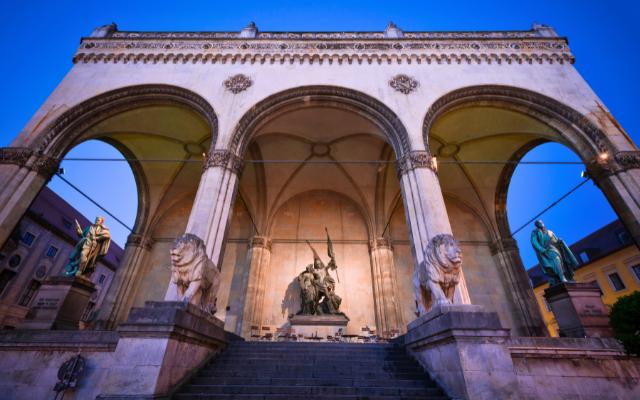
9. Feldherrnhalle
The Feldherrnhalle is a monumental hall located at the southern end of Munich’s Odeonsplatz, between Theatinerstraße and Residenzstraße.
It was built between 1841 and 1844 by the famous architect Friedrich von Gärtner. The hall was constructed in the style of Renaissance architecture and is considered to be one of the most important landmarks of Munich.
King Ludwig I had the structure built as a tribute to the glory of the Bavarian army. The two bronze statues in the side arcades were cast from melted canons: they depict the Count of Tilly, a victorious general in the Catholic League during the Thirty Years’ War, and General Johann Tserclaes, Count of Tilly.
The Feldherrnhalle plays an important role in Munich’s history. It was the site of the failed Beer Hall Putsch in 1923, where Adolf Hitler and his supporters tried to overthrow the Bavarian government. Today, the hall is a popular tourist attraction and a symbol of Bavarian pride.
Visitors can admire the impressive architecture of the hall, which features 20-meter archways and intricate details. The hall is also home to several statues, including a lion sculpture by Wilhelm von Rümann and a statue commemorating the Franco-Prussian War.
Our full article on the Feldherrnhalle entitled Feldherrnhalle: Munich Field Marshals’ Hall [What Is It?] is the go-to read if you wish to find out more about this Famous Munich Landmark.

10. Karlstor
The Karlstor, formerly known as the Neuhauser Tor, is one of Munich’s most famous landmarks. Built between 1285 and 1302, it served as one of the city’s main defensive fortifications and checkpoints during the medieval ages until the late 18th century. The gate is located at the western end of Neuhauser Straße, which is part of Munich’s downtown pedestrian zone.
The Karlstor is a Gothic-style gate that features two towers and a central archway. The gate was named after Karlsplatz, the square adjoining it. The square is named after Karl Theodor, the Elector of Bavaria, who ruled from 1777 to 1799.
The Karlstor is one of the three remaining gates to Munich’s Old Town, the other two being the Isartor in the east and the Sendlinger Tor in the south. The gate is a popular tourist attraction and a must-visit for anyone interested in Munich’s history and architecture.
Visitors can walk through the gate and explore the surrounding area, which is home to several shops, restaurants, and cafes. The gate is also close to other famous landmarks, such as the Marienplatz and the Frauenkirche Onion Domes.
Overall, the Karlstor is a fascinating piece of Munich’s history and a testament to the city’s rich cultural heritage. Its Gothic-style architecture and historical significance make it a must-visit for anyone traveling to Munich.Find out more by looking over our full blog post entitled Karlstor: Munich’s Main City Gate REVEALED!
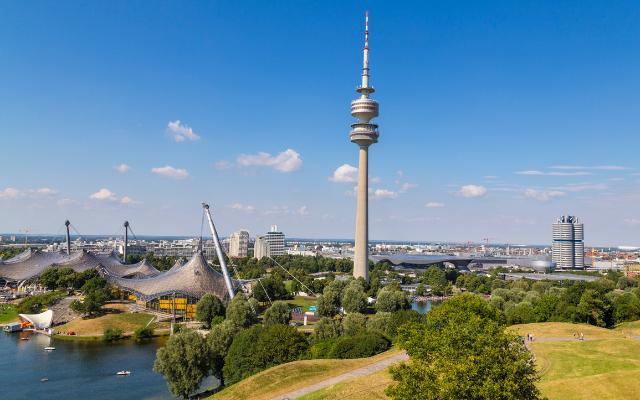
11. Olympic Tower
The Olympic Tower is one of the most famous landmarks of Munich. It is located in the Olympiapark, which was built for the 1972 Summer Olympics. The tower stands at a height of 291 meters and is the tallest structure in Munich.
The tower is a popular tourist attraction, offering panoramic views of Munich and the surrounding countryside. Visitors can take an elevator to the observation deck at a height of 190 meters, where they can enjoy breathtaking views of the city and the Alps.
On a clear day, visitors can see as far as 80 kilometers.
The tower also has a revolving restaurant, which offers a unique dining experience. The restaurant completes a full rotation every 53 minutes, giving diners a constantly changing view of Munich. The restaurant serves a variety of Bavarian and international dishes, as well as a selection of wines and beers.
The Olympic Tower is part of the Olympiapark complex, which also includes the Olympic Stadium, the Olympic Hall, and the Olympic Village. The complex was designed by the renowned German architect Frei Otto and is a masterpiece of modern architecture.
The Olympiapark is a popular destination for sports enthusiasts, nature lovers, and culture seekers alike.
The Olympic Tower is definitely an iconic landmark of Munich that offers visitors a unique and unforgettable experience and is a must-see when in Munich.
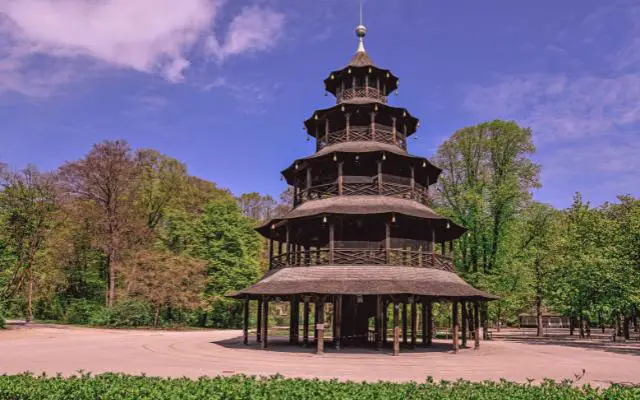
12. Chinese Tower
The Chinese Tower in Munich (Chinesischer Turm in German) is a famous landmark located in the middle of the English Gardens.
The tower is a 25-meter high, five-story, polygonal structure that resembles a pagoda. It was constructed entirely out of wood in 1789-1790 and was opened to the public as an observation deck in 1792.
The tower has a diameter of 19 meters at ground level and approximately 6 meters is the highest story. Visitors can climb up the tower to enjoy a panoramic view of the English Garden and Munich city.
The tower is also home to a restaurant and beer garden that can accommodate up to 7,000 people.
The Chinese Tower is one of the most famous beer gardens in Munich and is a popular destination for locals and tourists alike. The beer garden is open from late April to late September and serves traditional Bavarian food and beer.
Visitors can enjoy live music performances by local bands and musicians in the evening making the unique architecture, stunning views, and lively atmosphere here an unforgettable experience for visitors of all ages.
The Chinese Tower is easily accessible by public transportation, including bus lines 54/154, streetcar 18, U3, and U6. It is also within walking distance from other famous landmarks in the English Garden, such as the Monopteros temple and the Kleinhesseloher Lake.
Our full article entitled Chinese Tower Munich & The Chinesischer Turm Biergarten should be your first port of call if intending to visit here.
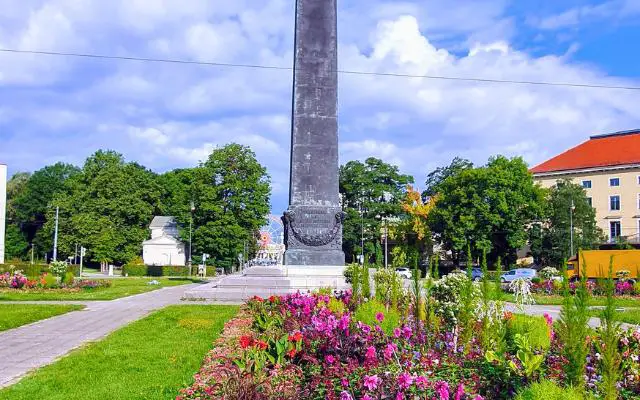
13. Black Obelisk At Karolinenplatz
Karolinenplatz is a historical square in Munich that features a prominent monument known as the Obelisk. This 29-meter-tall black obelisk was erected in 1835 by King Ludwig I of Bavaria to commemorate the 25th anniversary of his coronation and to honor the Bavarian soldiers who died in various wars.
The Obelisk is made of dark granite and stands in the middle of a lawn decorated with flowers. It was designed by Leo von Klenze, a well-known Royal Court architect, in an Egyptian style with inscriptions in Latin and Greek.
The obelisk is a prominent feature of the square, and its height and dark color make it visible from a distance.
The Obelisk at Karolinenplatz is also known as a war memorial, as it was built to commemorate the Bavarian soldiers who lost their lives in various wars.
The monument was constructed using the captured Turkish guns from the Battle of Navarino in 1827, which explains its dark color.
Today, the Obelisk is a popular attraction for tourists and locals alike. Visitors can take a stroll around the square and admire the monument’s impressive design and historical significance. The square is also home to other landmarks, including the Amerikahaus, a cultural center that promotes German-American relations.
Check out the full article at the following link Karolinenplatz Munich | Roundabout & Colossal Black Obelisk
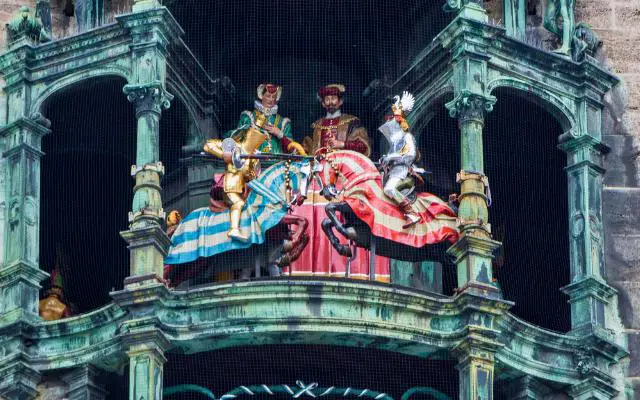
14. Glockenspiel
The Glockenspiel is one of the most popular attractions in Munich and a must-see for tourists visiting the city.
Located in the tower of the New Town Hall (Neues Rathaus) in Marienplatz, the Glockenspiel Munich is a large mechanical clock that chimes twice a day, at 11 am and 12 pm. The clock is famous for its life-size figures that reenact scenes from Munich’s history.
The Glockenspiel has three levels, each with a different theme. The top level depicts the wedding of Duke Wilhelm V and Renata of Lorraine in 1568, with 32 life-size figures acting out the story. The middle level shows the Schäfflertanz, a traditional dance performed by coopers during the plague in 1517. The bottom level portrays the Coopers’ Revolt, a historical event that took place in Munich in 1705.
The Glockenspiel is a masterpiece of engineering and craftsmanship. It was first installed in 1908 and has been entertaining visitors ever since.
The clock is operated by a complex system of gears and weights, which are wound up every day by a clockmaker. The figures are made of wood and are painted in bright colors, giving them a lifelike appearance.
Visitors can watch the Glockenspiel from the square below or from the balcony of the Neues Rathaus. The show lasts for about 15 minutes and is accompanied by music played on a set of 43 bells.
This is a true masterpiece of engineering and craftsmanship and is not to be missed if you love a bit of musical art & frivolity. To find out more read our full article – Glockenspiel Munich | The Mesmerizing Marienplatz Story Clock

15. Sendlinger Tor
Sendlinger Tor is a city gate located at the southern end of Munich’s historic old town area and is one of the three remaining Gothic town gates in Munich (the other two being the Isartor and the Karlstor).
The gate was built in the 14th century and served as a fortification for defense. It was originally part of the city wall that surrounded the Altstadt.
Although barely damaged throughout the war years the gate has undergone several renovations over the past number of decades with the most recent one taking place in 1980.
Today, the Sendlinger Tor is an important traffic junction and a popular landmark in Munich. It is part of the city’s historic old town and serves as a gateway to the Isarvorstadt and Glockenbachviertel districts.
The gate marks the southern tip of the Altstadt and connects to the bustling shopping street of Sendlinger Strasse.Sendlinger Tor is a popular spot for tourists and locals alike, who come to admire its impressive architecture and learn about its very interesting history and it’s a very well-known meeting point thanks to the hub that is the underground train station here.

16. Onion Domes of the Frauenkirche
The distinctive onion domes of the Frauenkirche are the iconic symbol of Munich’s skyline.
Perched atop the twin church towers, the bulbous copper domes are architecturally unique and offer panoramic city views for those who climb the 329 steps.
Though uncommon for a Christian church, the ornamental domes reflect Munich’s cosmopolitan history and have become beloved emblems of the city.
When you gaze up at the domes, you feel transported back to the 1400s when the first bricks were laid.
Surviving World War II bombing, the domes were later reconstructed, standing as resilient symbols of Munich’s past, present, and future. Their recognizable silhouettes capture the spirit of the city and their effigy can be spotted on all manner of touristic items sold throughout the city.
For more on the Onion Domes and the Frauenkirche please feel free to read our comprehensive article entitled Frauenkirche Munich: Munichs Amazing Cathedral
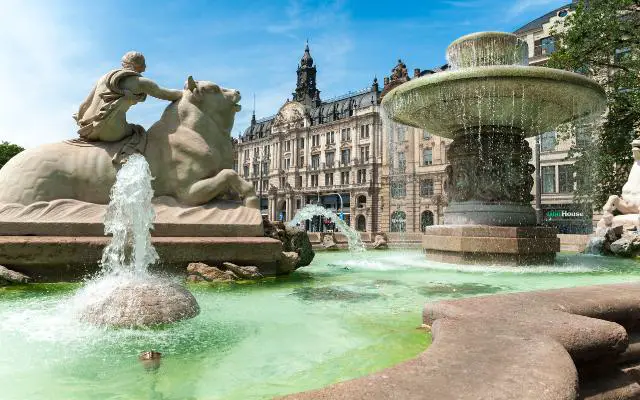
17. Wittelsbacher Fountain
Nestled at the heart of Munich’s bustling Maximiliansplatz lies the captivating Wittelsbacher Fountain (Wittelsbacher Brunnen), an inviting neoclassical masterpiece.
Crafted with meticulous artistry between 1893 and 1895, this exquisite monument bears the creative touch of sculptor Adolf von Hildebrand, complemented by the skillful hands of sculptor Erwin Kurz.
Central to its design is the figure of Otto I, the pioneering ruler of the revered Wittelsbach dynasty. Encircled by the graceful presence of tritons and river gods, representing Bavaria’s four iconic rivers – the Danube, Inn, Isar, and Lech – the fountain narrates tales of ancient waters.
Drawing wanderers and culture enthusiasts alike, the fountain stands as a cherished beacon for tourists, its allure likened to a gem among Munich’s treasures.
Many people do not actually know this but in fact this fountain was erected in commemoration of the completion of city’s new municipal water-supply system.
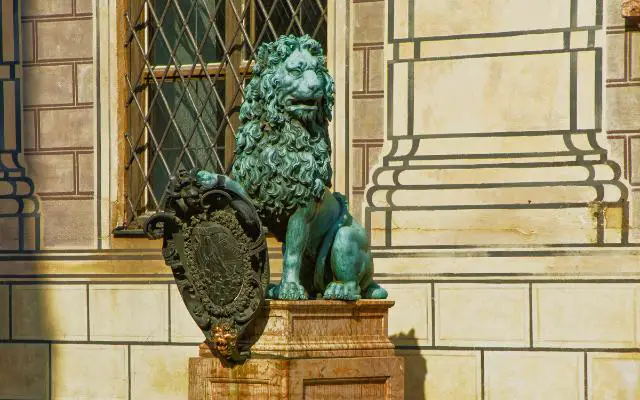
18. The (Lucky) Lion Statues at The Munich Residenz
Welcoming visitors to The Residenz in Munich, the Lion Statues here stand as silent sentinels, their presence shrouded in mystique.
These statues are more than mere stone; they’re bearers of an ancient belief in luck and fortune that has endured through generations.
The aura of luck that envelops these statues isn’t just happenstance. Legend has it that those who touch the lions are bestowed with a dose of luck and blessings.
As the centuries have passed, the belief in their benevolence has only grown stronger. It’s not uncommon to see tourists and locals alike reaching out to make contact with the statues as if seeking a direct line to destiny.
Perhaps it’s the sense of connection to history that draws people in – the feeling of being part of a lineage of believers spanning back in time. Or maybe it’s the sight of these regal lions, with their dignified expressions and outstretched paws, that sparks a flicker of hope in the hearts of those who encounter them.
At the heart of Munich’s historic Residenz, these lion statues hold more than meets the eye. They hold a promise of luck, a brush with destiny, and a link to the narratives of countless individuals who’ve stood before them in search of something magical.
As you stand in their presence, you can’t help but wonder if perhaps, just perhaps, a bit of that legendary luck might find its way into your life too.
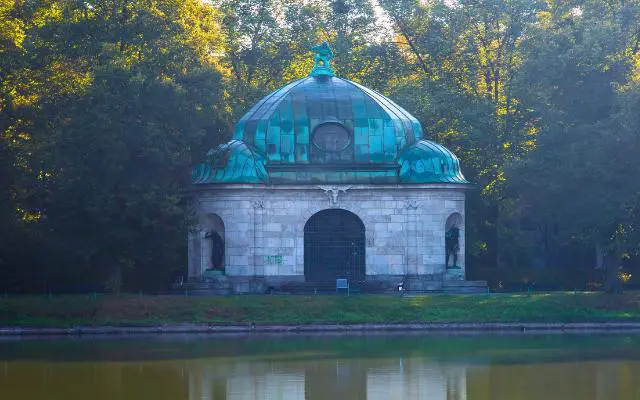
19. Hubertusbrunnen
The Hubertusbrunnen is a well system located in the west of Munich at the eastern end of the Nymphenburg Canal.
The Hubertus Fountain was created by Adolf von Hildebrand and Carl Sattler and was built from 1903 to 1907 in tribute to Prince Regent Luitpold.
Originally placed at Bavarian National Museum, it was relocated in 1954 to Nymphenburg Palace Canal on Waisenhausstrasse.
Designed as a covered temple, it features a stag figure within a water basin and a statue of Saint Hubertus atop its roof.
The fountain’s history includes removal in 1937 due to Nazi plans and restoration in 1954 with Crown Prince Rupprecht’s support, honoring donors who made it possible.
The Hubertusbrunnen is a beautiful Baroque-style fountain that features a statue of Saint Hubertus with a deer. The fountain is surrounded by a circular basin and is decorated with reliefs of hunting scenes. The water flows from the mouth of a lion’s head into the basin, creating a soothing sound that adds to the charm of the place.
The Hubertusbrunnen is situated in a beautiful park that is perfect for a leisurely stroll and leads all the way to Nymphenburg Palace. The park features lush greenery, trees, and benches where visitors can sit and relax. The park is also a popular spot for picnics and outdoor activities, such as jogging and cycling.
Read all about this landmark in our article entitled Hubertusbrunnen: The Hidden Fountain On Nymphenburg Canal

20. King Ludwig I Statue
The very famous King Ludwig I Statue is a magnificent bronze statue located at in the Odeonsplatz in central Munich. It was erected in 1835 to honor King Ludwig I of Bavaria.
The bronze statue stands 13 meters tall atop a 9 meter high pedestal. It depicts King Ludwig I seated on a throne wearing royal robes and a crown. He holds a scepter in his right hand.
The statue was designed and built by German sculptor Ludwig Schwanthaler. It is considered one of the major public monuments
in Munich and a significant example of classicist sculpture. Directly adjacent is the wonderful Feldherrnhalle

21. Maximilian Joseph Statue
The Maximilian Joseph Statue is a prominent landmark located in the heart of Munich’s city center. The statue depicts King Maximilian Joseph, the first king of Bavaria, sitting on a throne. It was erected in 1835 by the architect Leo von Klenze in honor of the king’s reign.
The statue is made of bronze and stands at a height of 8.5 meters. It is situated at Max-Joseph-Platz, which is named after the king. The square is surrounded by several notable buildings, including the National Theatre, Palace of Justice, and the Bavarian State Opera.
The statue is a masterpiece of the Rococo style, which was popular in the 18th century. The Rococo style is characterized by its ornate decorations, asymmetrical designs, and pastel colors. The statue’s intricate details and the king’s regal pose are a testament to the Rococo style.
The Maximilian Joseph Statue is not only a beautiful piece of art but also a symbol of Bavarian history. It serves as a reminder of King Maximilian Joseph’s contributions to the state and his legacy as its first king. Visitors to Munich can appreciate the statue’s beauty and significance by taking a stroll through Max-Joseph-Platz.

Bonus Munich Landmarks
The Dianatempel In Munich’s Hofgarten
The Diana Temple is a beautiful monument located in the Munich Hofgarten, the 17th-century-inspired Italian-styled Renaissance garden in the center of the city.
This neoclassical temple was built in 1615 by Heinrich Schön and serves as an artificial grotto. Visitors are drawn to the temple’s elegant white facade and striking domed roof.
Inside you’ll find an artificial waterfall and captivating rocaille decorations that soothe the visitor and create a feeling of calm and serenity.
The temple is dedicated to the Roman goddess Diana and makes for an enchanting sight while strolling through the gardens. Be sure to visit this picturesque temple when exploring the Hofgarten Munich and the nearby Feldherrnhalle on Odeonsplatz, Egyptian Museum, and the Munich Residenz.
Munich Landmarks | What We Think
Phew, that was a long article to write but we hope you enjoyed our take on the Top 21 Munich Landmarks.
There are plenty more unique and interesting Munich Landmarks to discover for yourself over and above our curated list (above) so why not get out there and explore this wonderful city?
Whether you’re a history buff, architecture aficionado, art enthusiast, or simply love immersing yourself in culture, Munich’s landmarks will leave you in awe.
With this guide, you can easily navigate the city’s top sites, admiring man-made marvels at every turn.
When visiting Munich, be sure to look up, look back, and discover the rich stories these landmarks have to tell.
Cheers and thanks for reading.
What Are Some Historical Sites Related To WWII In Munich?
Munich played an important role in WWII, and there are many historical sites related to the war in the city. Some of the most notable sites include the Dachau Concentration Camp Memorial Site, the Feldherrnhalle, and the Führerbau, which was used by Adolf Hitler and other Nazi officials.
What Are Some Of The Oldest Buildings To See In Munich?
Munich has a rich history and is home to many old buildings. Some of the oldest buildings in Munich include the Frauenkirche (built in the 15th century), the Old Town Hall (built in the 14th century), and St. Peter’s Church (built in the 12th century).
Where Are The Castles In Munich Located?
Munich has many famous palaces but only two actual castles. Grünwald Castle is located in the south of the city and Blutenburg Castle located in the western suburbs of the city.
What Is The Oldest Street in Munich?
Kaufingerstraße is the oldest recorded named street in Munich. Flanked by shops and cafes, this lively lane leads to bustling Rindermarkt plaza in the Altstadt’s heart.
What Are Some Popular Things To Do In Munich Besides Visiting Landmarks?
Munich has a lot to offer besides its famous landmarks. Visitors can enjoy a beer at one of the city’s many beer halls, explore the Englischer Garten, or visit one of the city’s many museums, such as the Deutsches Museum or the Pinakothek der Moderne. The city is also known for its shopping, with many high-end stores and boutiques located in the city center.
